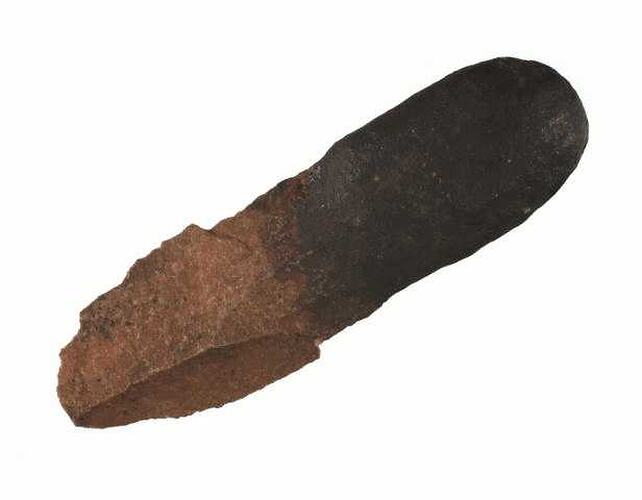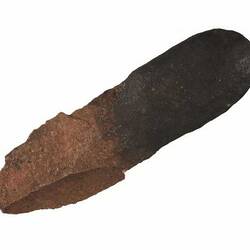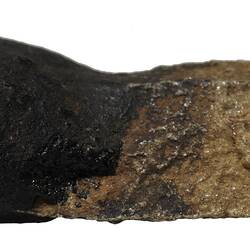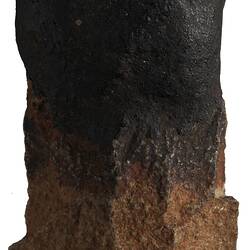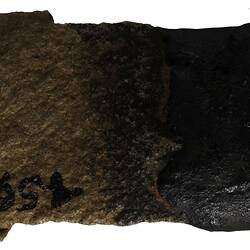Summary
Stone was the heaviest and most durable material available for Aboriginal people in Australia, with sophisticated and efficient tools such as knives being made using a variety of techniques including grinding and flaking. Flaking involved the removal of controlled pieces or flakes of stone from a larger piece called a 'core.' Two basic methods of flaking include shaping the core by flaking with a hammerstone, which is usually made from a tougher rock than the core; or treating the core as a source of raw material, with the flakes being removed and used as tools, either as they come off the rock or after refinement through trimming.
Small flaked knives such as this were often equipped with a resin haft, allowing for more comfortable handling during use which included food preparation and the manufacture of implements. This hafted stone knife was obtained from a shell midden on a beach near Cape Otway in Victoria's Western District, with this area being the traditional lands of the Gadubanud peoples, commonly referred to as the 'Cape Otway people'. In 1881 amateur ethnographer James Dawson recorded the Cape Otway language group as 'Katubanuut' and asserted that this meant 'King Parrot language' in the local dialect.
Middens located along Cape Otway beaches reveal the lifestyle and varied diet of the Gadubanud including turban shells, abalone, periwinkle, eels and ducks.
In 1846, a party of colonial men from Melbourne, led by surveyor George G Smythe, massacred many Gadubanud men, women and children in what is sometimes known as the Blanket Bay Massacre.
Although many Aboriginal people in western Victoria are descendants of the Gadubanud peoples, the Gunditjmara peoples are now the active custodians of traditional Gadubanud lands of the Cape Otway region.
Physical Description
Knife, quartzite flake hafted with gum.
Significance
Elder and respected writer and historian Bruce Pascoe explains the skill and ingenuity First Peoples have shown in the manufacture of stone tools over hundreds of generations;
'A huge variety of stone tools were manufactured using a sophisticated technique of napping flint, greenstone, silcrete, quartz, chert and other hard stones. Without steel, Aboriginal people were able to make axes with wooden handles, spears with barbs and points, knives with incredibly sharp blades, scrapers, spoke shaves, grinding tools and a host of other useful implements. Flint and greenstone axes with ground edges were bound into cleft sticks using kangaroo sinew and grass tree resin. The sinews contracted and tightened as they dried while the resin acted as a super bonding glue.'
Bruce Pascoe, 2012
Reference: http://barwonbluff.com.au/archive/koorie/Tools%20.htm
More Information
-
Object/Medium
Knife, hafted
-
Maker
-
Locality
-
Date Produced
-
Object Measurements
130 mm (Length), 40 mm (Width), 25 mm (Height)
-
Classification
-
Date Made
-
Maker
-
Clan/Language Group
-
Place Made
-
Indigenous Region
-
Keywords
-
Type of item
-
Discipline
-
Category
-
Collecting Areas
